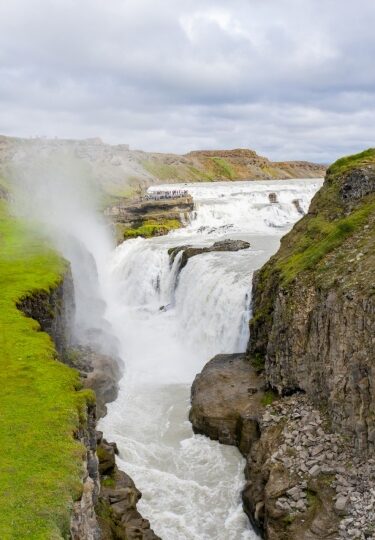The best places to visit in Iceland range from powerful waterfalls to the vast glaciers that can be seen from space, and downtown Reykjavik, with its independent shops, street art, and café culture. There are ice-capped volcanoes, black-sand beaches, and serrated mountains, with offbeat museums and microbreweries among the best places to visit, too.
From remote islands where you might spot pods of orca and migratory birds to a gleaming hilltop church in Reykjavik, add these 15 places to your Iceland bucket list.
Hallgrimskirkja
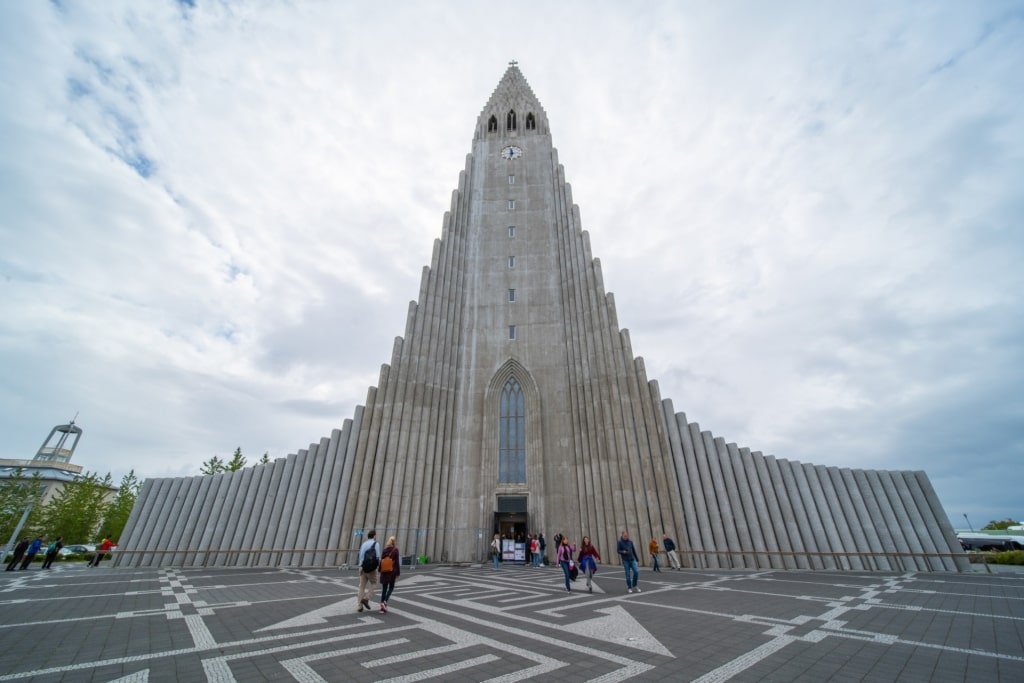
Hallgrimskirkja
Not only is Reykjavik’s Hallgrimskirkja the tallest church in Iceland, it’s one of the most iconic religious buildings in the world. Its striking design is inspired by Iceland’s tectonic landscape, with basalt-like columns rising to form a cloud-piercing pointed crescendo.
Designed by one of the country’s most influential architects, Guðjón Samúelsson, Hallgrimskirkja was completed in 1986 and is one of the best places to visit in Iceland. Stop by the church to admire its architecture on a tour.
The vaulted ceilings inside are as stark as the outside of the building, while the tower offers fantastic views across the capital city of Reykjavik.
Godafoss
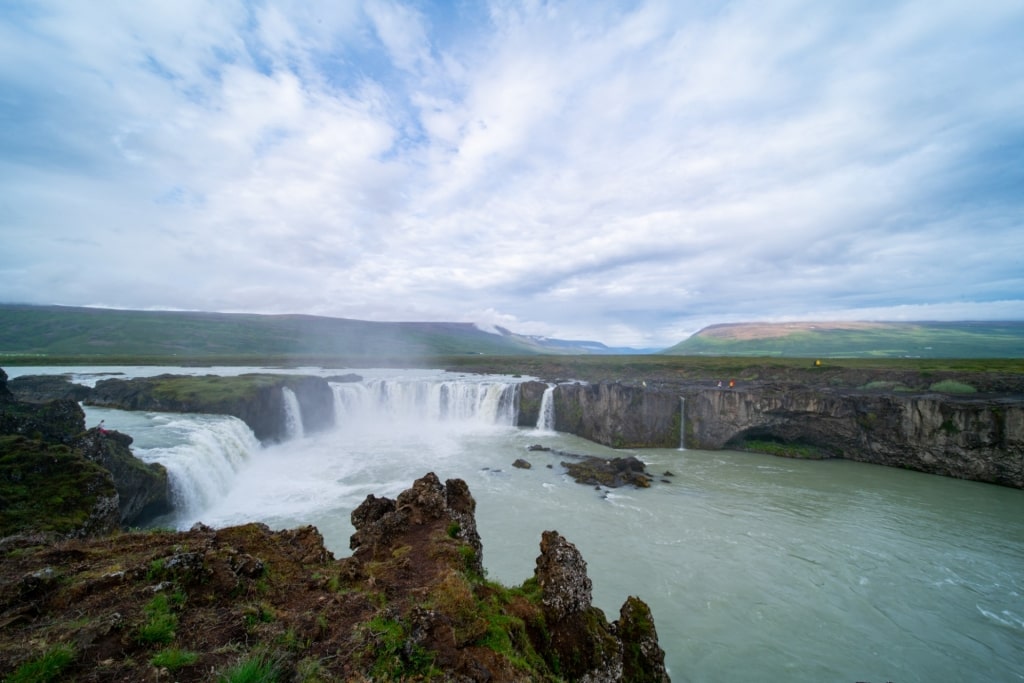
Godafoss
Pack your camera and waterproofs to gaze at Godafoss, one of the most dramatic waterfalls in Iceland.
Godafoss’ sweeping crescent-shaped drop is located in northern Iceland. It’s an easy day trip from Akureyri and well worth a visit to savor the foaming teal water plummet 39 feet.
Known as the Waterfall of the Gods, Godafoss is a highlight of the Skjalfandafljot, Iceland’s fourth-largest river. While its drop might not be the biggest in Iceland, it spans 100 feet, with the water tumbling over a curved edge to create a spectacular sight.
National Museum of Iceland
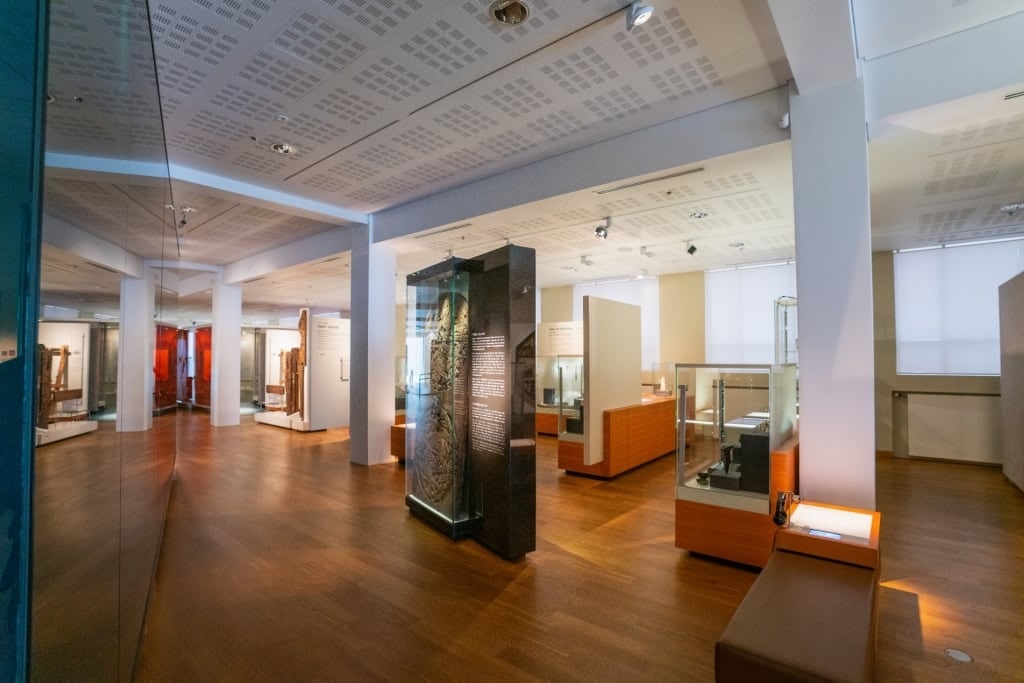
National Museum of Iceland, Reykjavik
Reykjavik has some fantastic museums, including the National Museum of Iceland, the country’s oldest. The museum was established in 1863 by Jón Árnason who curated the Icelandic Antiquities Collection.
As the museum has evolved, it has grown to encompass many collections that examine the history and culture of Iceland.
The Making of a Nation is a permanent collection that stages Iceland’s history from the ninth century, including the Age of Settlement, right up to the 20th century. It all starts with a ship on which medieval settlers arrived on and takes visitors on a journey through 2,000 objects and around 1,000 photographs, through to the construction of the capital’s modern airport.
Siglufjordur
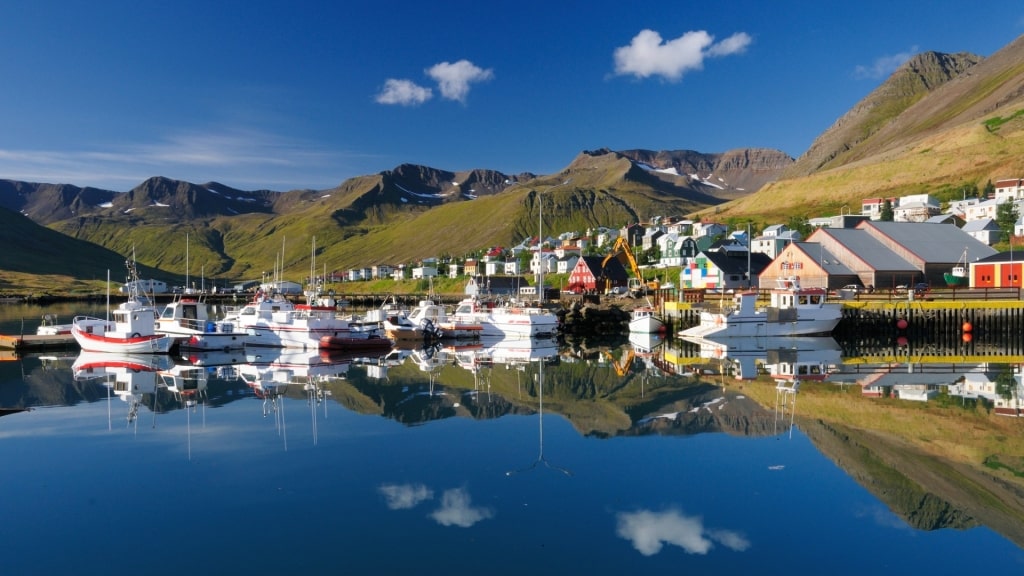
Siglufjordur
Add a visit to Siglufjordur, the northernmost town in Iceland to your travel resume. Siglufjordur is a remote fishing village, nestled on an Icelandic fjord that, during summer, basks under the midnight sun.
In the first half of the 20th century, Siglufjordur had its own “gold rush” era, becoming the booming herring fishing capital of the North Atlantic.
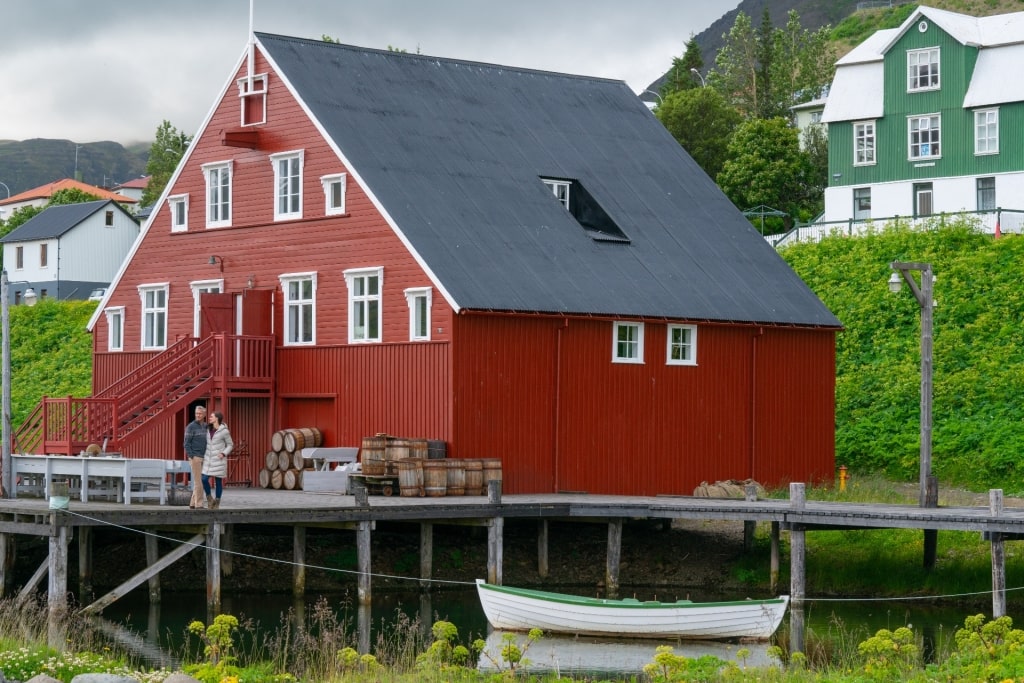
Herring Era Museum, Siglufjordur
The town’s fascinating Herring Era Museum is dedicated to this period, covering everything from where and how herring is caught and stored, to how it’s distributed.
A highlight is Róaldsbrakki, a former Norwegian salting station that dates back to the early 1900s that once housed workers known as the “herring girls”, tasked with salting the fish.
Call into Siglufjörður’s mustard-yellow Folk Music Centre, too. The one-time home of reverend Bjarni Þorsteinsson, known as the Father of Siglufjörður, showcases old Icelandic folk songs and nursery rhymes. They’re fascinating niche museums.
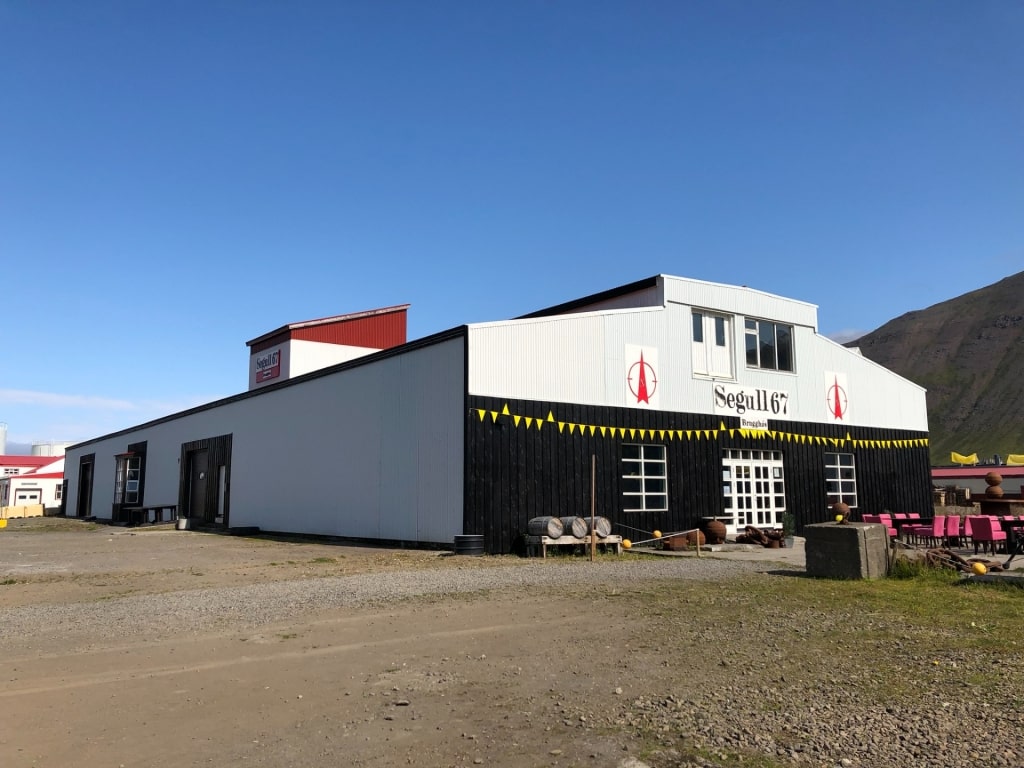
Segull 67 Brewery, Siglufjordur
After a stroll around the pretty harbor town, visit one of Iceland’s best breweries. At Segull 67 Brewery, you’ll find delicious local brews, including the easy-drinking amber lager.
Read: Midnight Sun in Iceland
Reynisfjara Beach
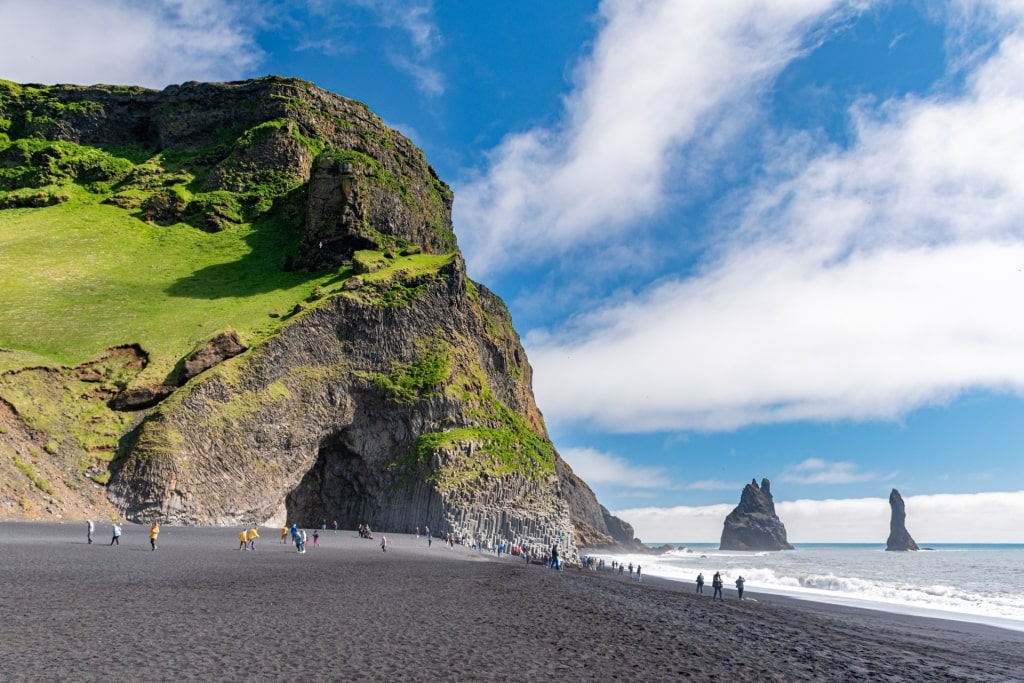
Reynisfjara Beach
Rugged Reynisfjara is a black sand beach on the south coast of Iceland, roughly two and a half hours’ drive from Reykjavik.
What makes Reynisfjara one of the best places to visit in Iceland? Aside from its dramatic sand, the beach is pummeled by wild Atlantic waves and features towering, anthracite-colored basalt stacks.
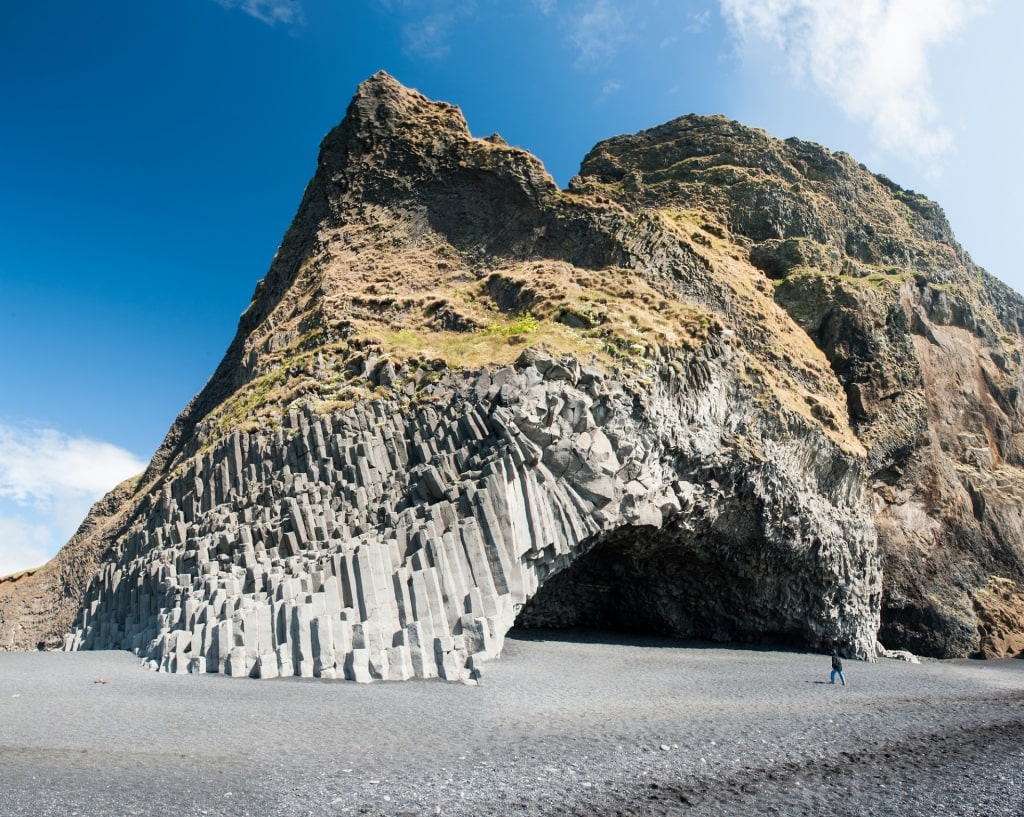
Hálsanefshellir Cave
Wrap up warm to roam the windswept beach, including Hálsanefshellir Cave by the basalt stacks. On a clear day, visitors can spot Dyrholaey’s sea arch in the distance, to the west.
It’s not only location scouts that fall for this cinematic beach in Iceland. The serrated sea stacks that rise from the water are home to thousands of guillemots, puffins, and fulmars.
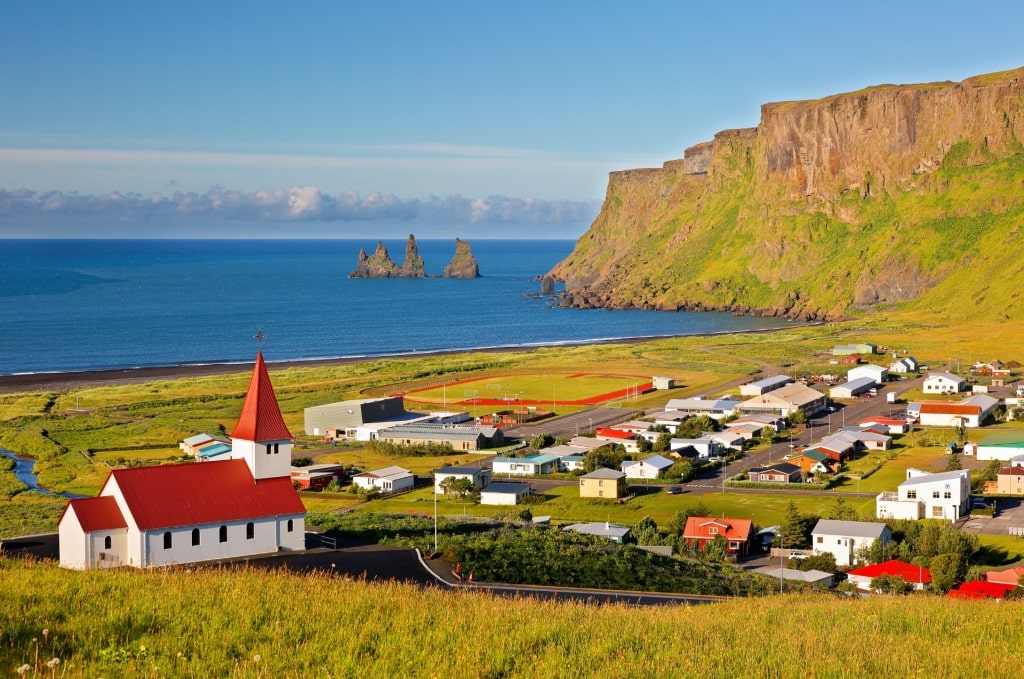
Vík
Stop by the village of Vík, a short drive from the beach, to see its quaint hilltop church and pick up souvenirs at Katla, its wool studio and shop. There is a scattering of cafés and restaurants, including Suður-Vík, where you can enjoy rib-sticking chocolate cake, pancakes, and waffles.
Grimsey Island
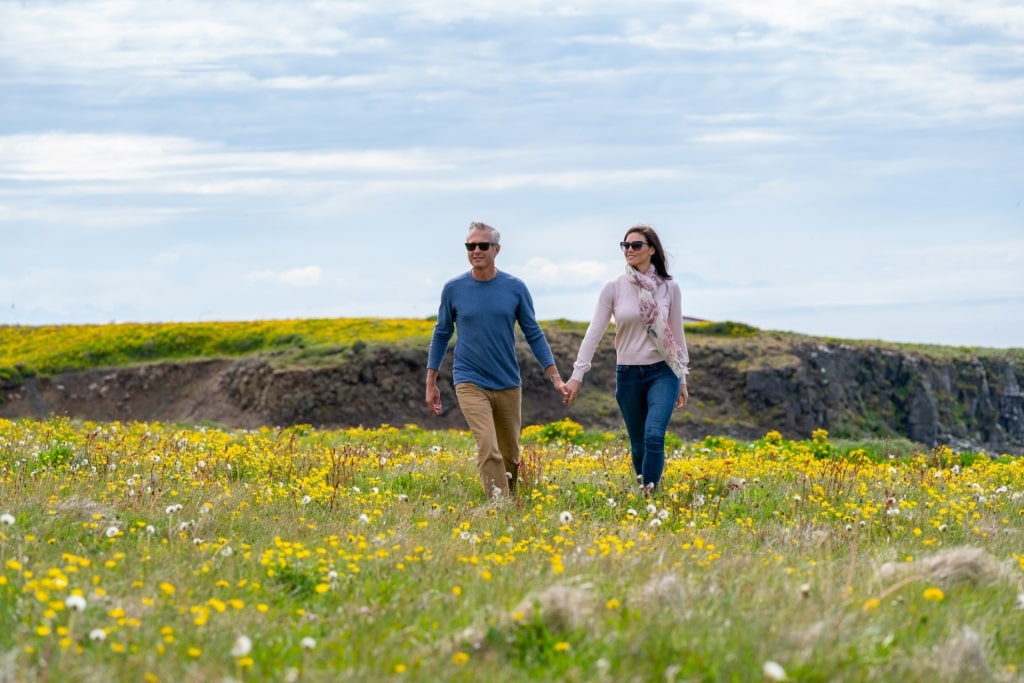
Grimsey Island
The Arctic Circle crosses faraway Grimsey, a speck of an island 25 miles north of the mainland where birds far outnumber humans during summer in Iceland. The island is only inhabited by a few fishermen and their families who form the island’s small and welcoming community.
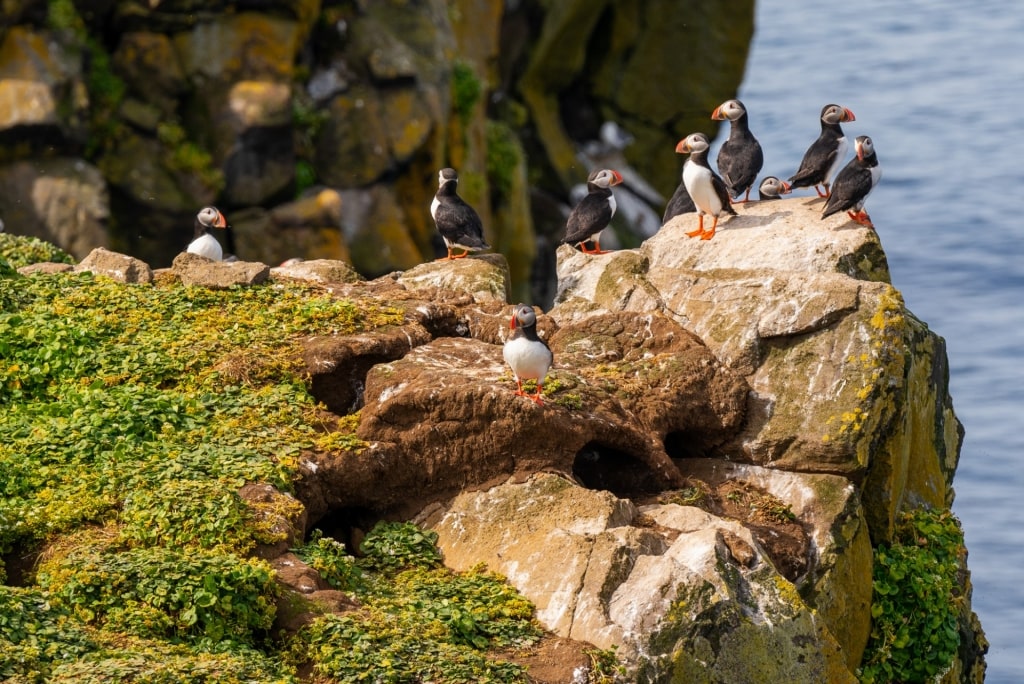
Puffins
Iceland in June through late July is bathed in sunlight all day long, while puffins fill the upper reaches of green-covered Grimsey’s towering cliffs.
Enjoy a breezy hike to the southern tip of Grimsey to see its tangerine lighthouse and spot as many different bird species as possible, with terns, razorbill, and black-legged kittiwake also filling the island’s sky.
After spotting these brilliant birds, order fish and chips with a local beer at the island’s only restaurant, Krian.
You could take the three-hour ferry to Grimsey from Dalvik from the mainland. Or you could cross the Arctic Circle in style, via a short polar flight.
Dynjandi Waterfall
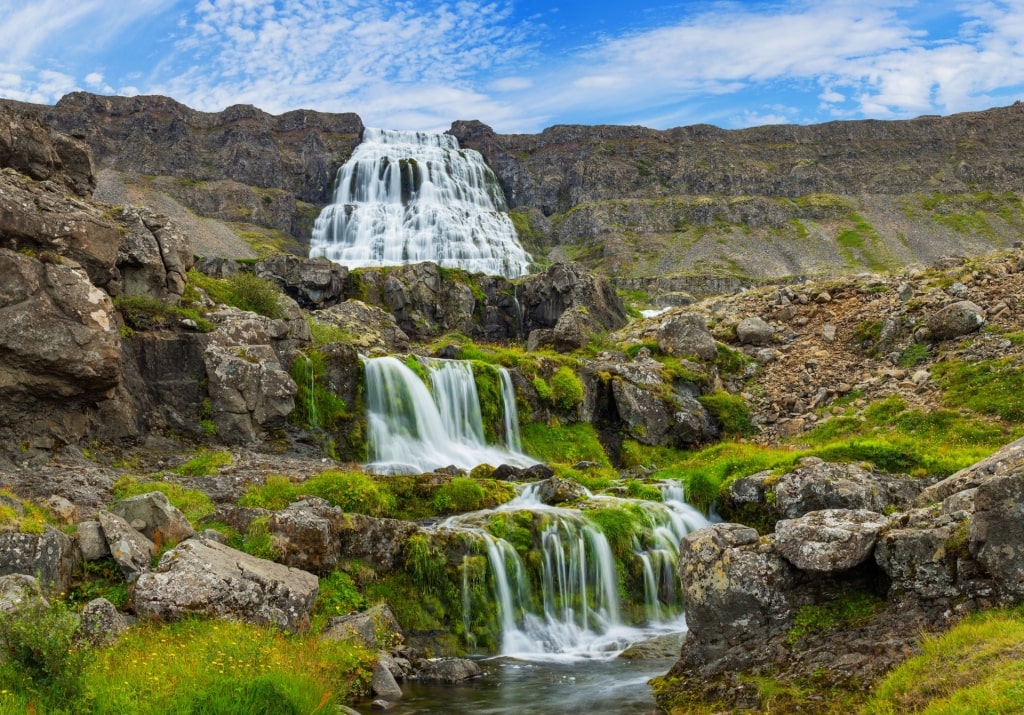
Dynjandi Waterfall
One of the best things to do in Iceland, Dynjandi is a beautiful 325-foot veiled waterfall located in the untrammeled Westfjords, amid fjords and mountains in the far northwest of the country.
Make the trip to Dynjandi from nearby Isafjordur, which takes around 50 minutes. From the car park, follow the river footpath, passing six smaller waterfalls—Baejarfoss, Kvislarfoss, Hrisvaosfoss, Gongumannafoss, Strompgljufrafoss, and Hæstahjallafoss—which takes around 11 minutes.
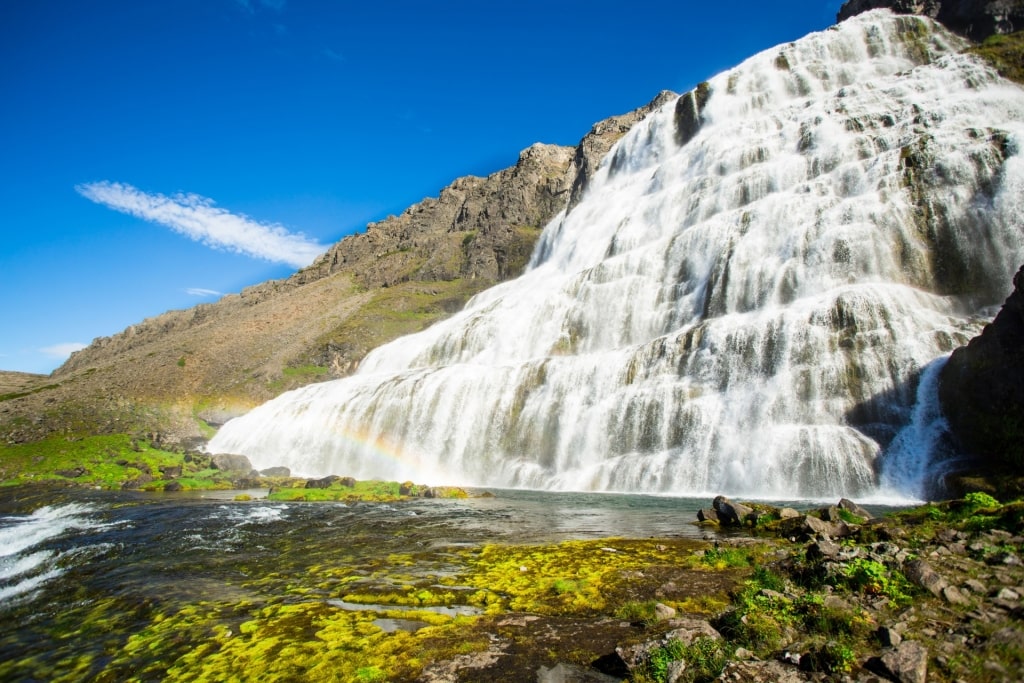
Dynjandi Waterfall
The path leads 656 feet up the side of the mountain, directly to the base of the cascading Dynjandi. Despite its lofty elevation, the walk typically takes just 10 to 15 minutes. Capture the spray as it fills the air and enjoy the impressive views of Arnarfjordur fjord, over which Dynjandi looms.
Myvatn Nature Baths
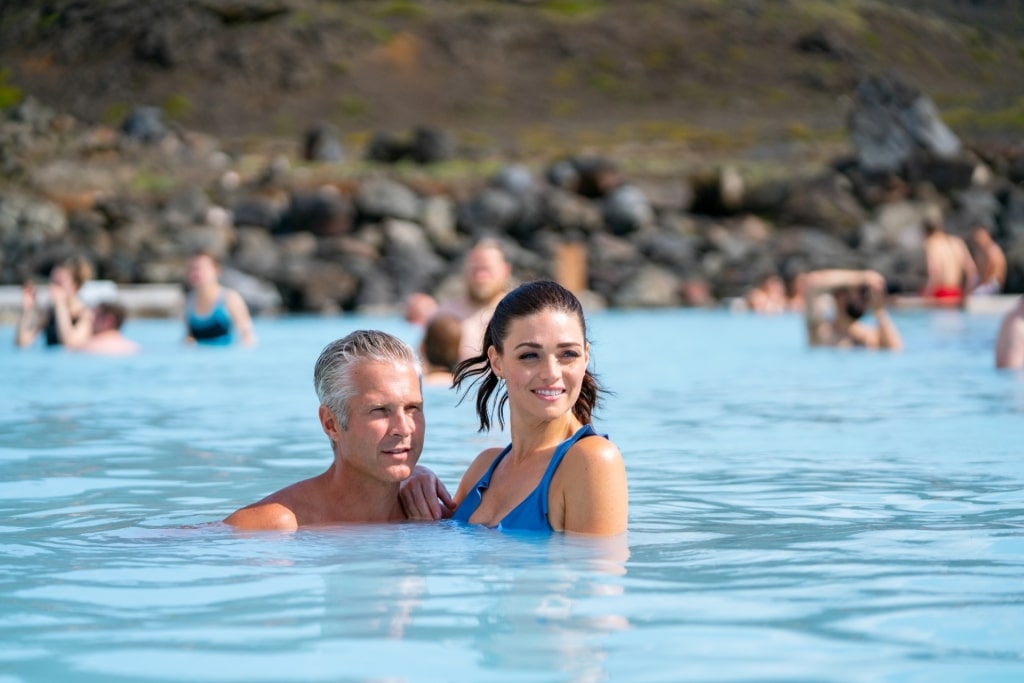
Myvatn Nature Baths
Just over 50 miles east of Akureyri and just 65 miles south of the Arctic Circle, Myvatn Nature Baths is one of the best places to visit in Iceland. Indulge in a relaxing soak in the milky-blue, geothermally-heated bathing pools near Lake Myvatn.
Though the lagoon complex is manmade, the mineral-rich water is naturally heated to 96°to 104°F (36 to 40°C) via a deep fissure in the earth’s surface. Steam baths, changing facilities, and a café serving delicious geyser bread with smoked char are among the facilities.
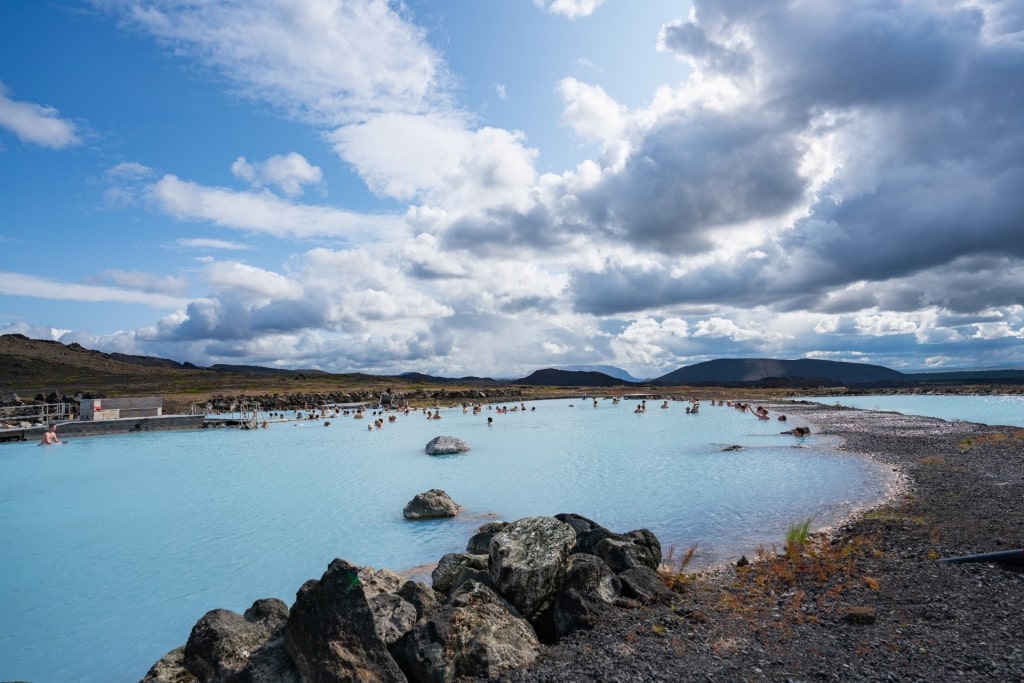
Myvatn Nature Baths
Myvatn’s steamy lagoon affords breathtaking mountain views, with Mt. Namafjall, the hot springs at Hverir, and Lake Myvatn, just a short drive from the baths.
Gullfoss
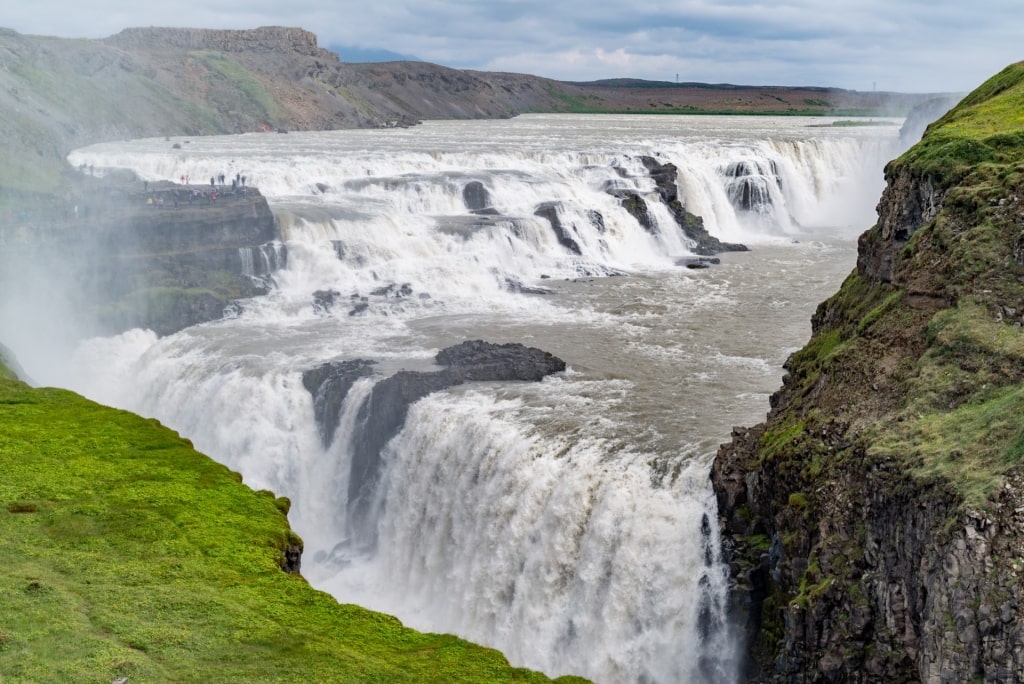
Gullfoss
Tremendous Gullfoss, which translates as Golden Falls, is one of the most beautiful places in Iceland. It’s found on the country’s 190-mile Golden Circle route, along with Thingvellir National Park and the Geysir Geothermal Area in the east of Iceland.
Gullfoss is located in a twisting canyon of the Hvítá River, with the frigid water flowing from the Langjokull glacier. There’s a path carved into the 230-foot canyon, which rises from both sides of the river for spectacular viewing.
Wear a waterproof jacket on a visit to Gullfoss as the glacial spray casts far and wide from the two-tier, 105-foot drop. During summer, 459 cubic feet of water surges through the canyon. It’s an impressive sight, and one of the best places to visit in Iceland.
Vigur Island
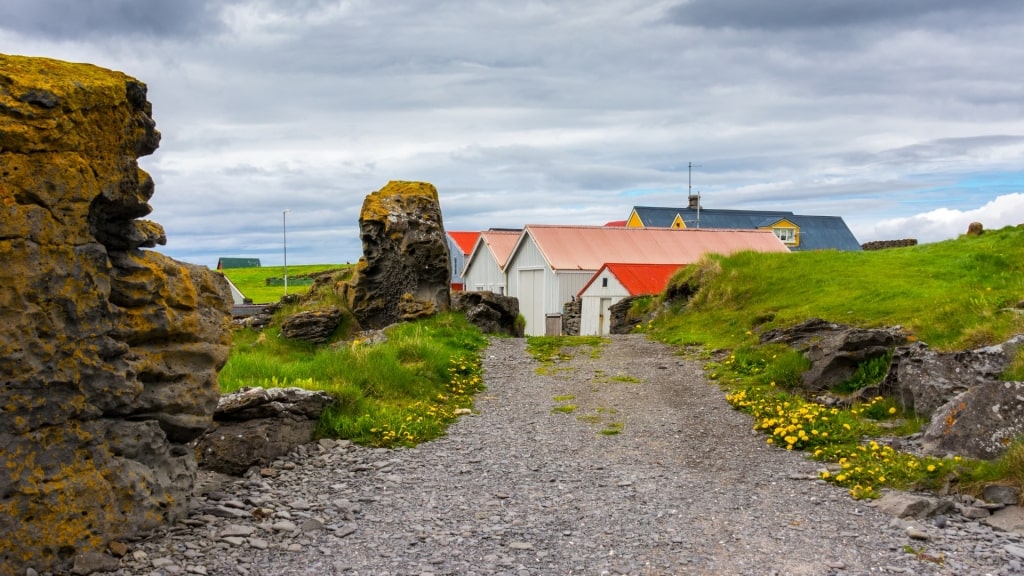
Vigur Island
The majority of the world’s eider comes from Iceland. Much of it is from the remote Vigur Island in the Isafjordur fjord in the Westfjords. The island is inhabited by one family, who operate the island’s eider farm.
Feathers left behind by the 7,000 nesting eider ducks are collected for harvesting and processing every summer. As well as eider ducks, a staggering 100,000 puffins, a rare colony of black guillemots, razorbills, and Arctic terns also descend on Vigur.
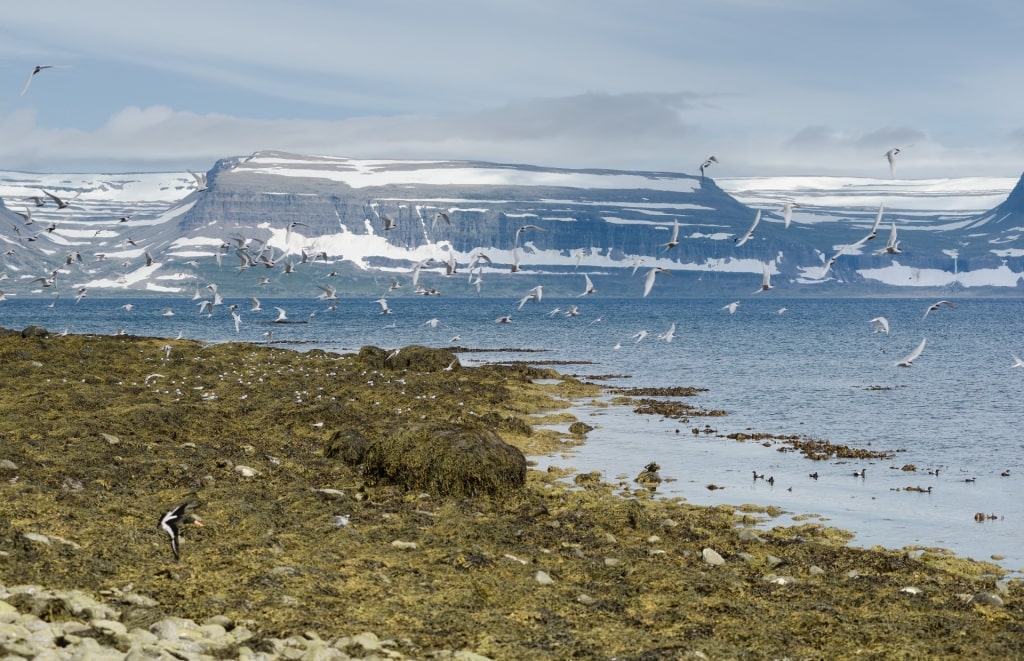
Vigur Island
The waters around Vigur are also teeming with wildlife, including dolphins, humpback whales, and harbor porpoises. Orcas and blue whales have also been known to make an appearance, making Vigur Island one of the best places to visit in Iceland for wildlife viewing.
There is no ferry service to Vigur, but tour operators run trips from Isafjordur between May and September. On a day trip to the island, see the annual eiderdown harvest in action, mail a postcard from the post office (the smallest in Europe), and enjoy coffee with a slice of Hjonabandssaela, a traditional jammy, coconut, and oatmeal pie.
Read: Best Things to Do in Isafjordur
Thingvellir National Park
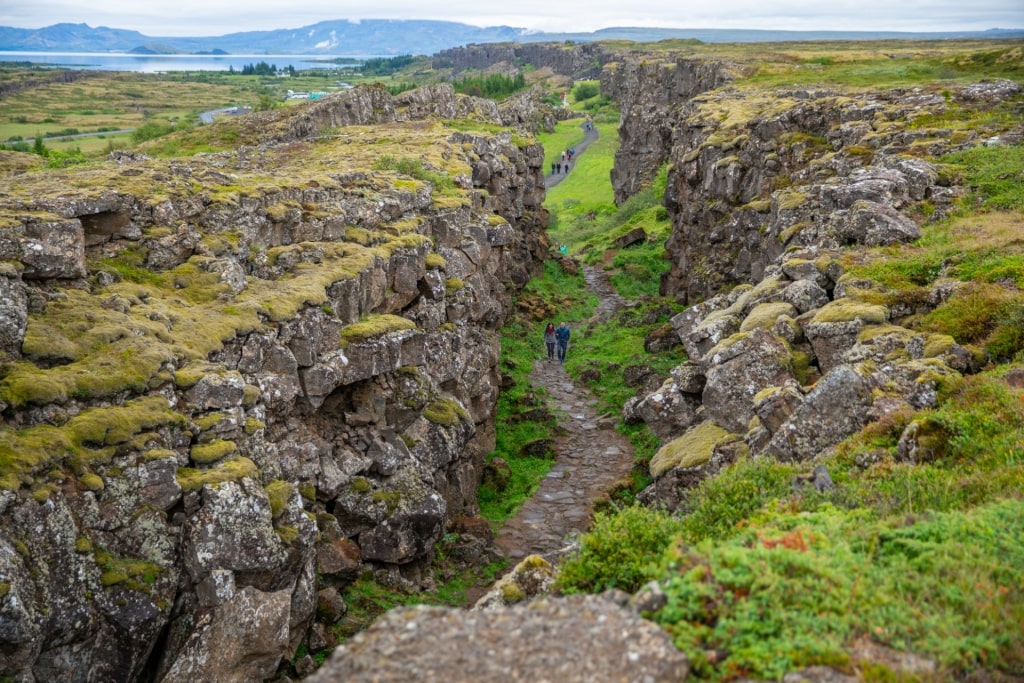
Thingvellir National Park
Visiting Iceland offers a chance to explore the UNESCO-listed Thingvellir National Park, where the country’s first parliament was established in 930. The country’s lawmakers, known as Althing (the supreme national parliament of Iceland), continued to meet here until 1798.
The remains of the open-air assembly can be seen in Thingvellir via a breezy 50-minute drive from the capital, with around 50 turf- and stone-built booths dating from the 10th century.
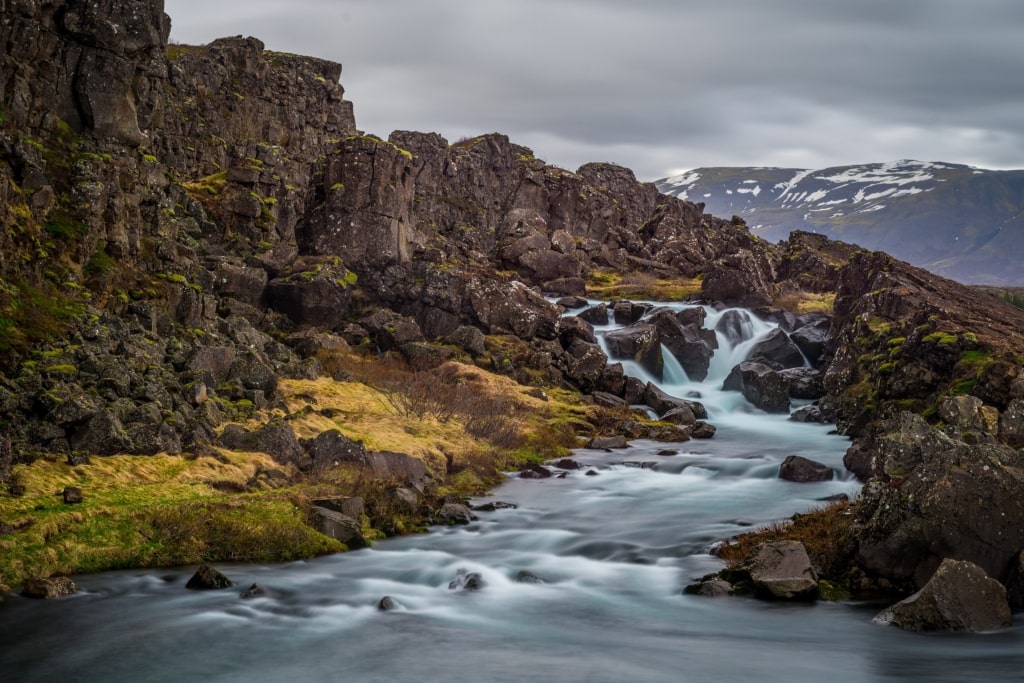
Thingvellir National Park
It’s easy to see why Iceland’s medieval lawmakers chose this spot. Its magnificent landscape includes Icelandic mountains, lava fields, basalt rock formations, waterfalls, rivers, and lakes, including the arctic char-filled Thingvallavatn, which straddles the North Atlantic Ridge.
Curious travelers can learn more about the location’s history, geology, and archaeology at the Thingvellir Visitor Center through the 40-minute Heart of Iceland exhibition. You can also pick up a hiking trail map from Thingvellir Visitor Center, with routes guiding walkers to the site of the abandoned farms of Hrauntún, Skógarkot, and Vatnskot.
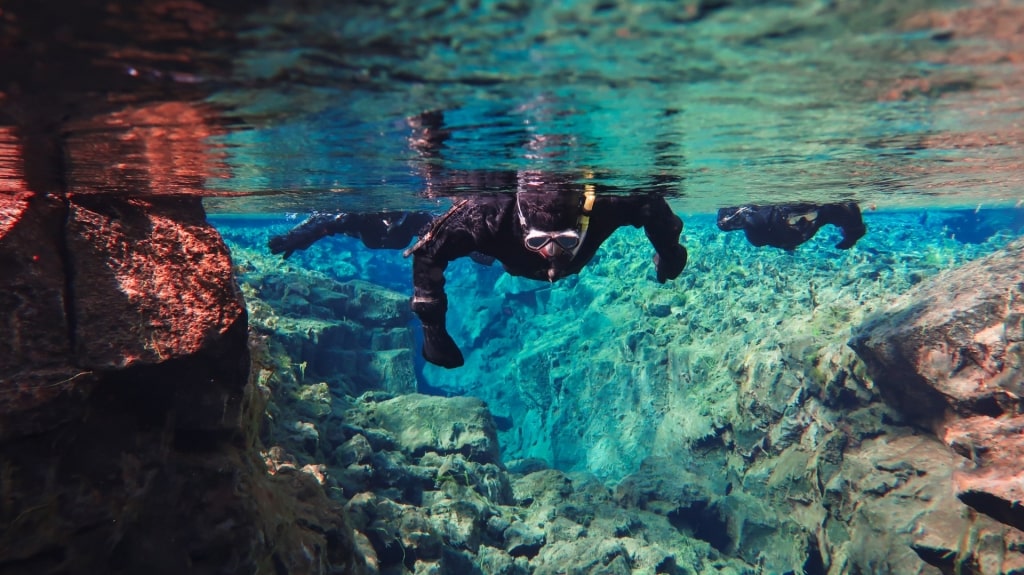
Silfra Fissure, Thingvellir National Park
Diving is popular at the Silfra Fissure in the northeast of Thingvallavatn close to the Visitor Centre. Silfra is considered one of the world’s best diving locations because of the water’s astonishing transparency. There are restrictions to be aware of—it’s not permitted to dive alone and divers need to have a dry suit certificate, or proof of 10 registered drysuit dives in the last two years, for example.
If you meet all of the requirements, it’s worth clambering into a drysuit to experience the jagged underwater world.
Downtown Reykjavik
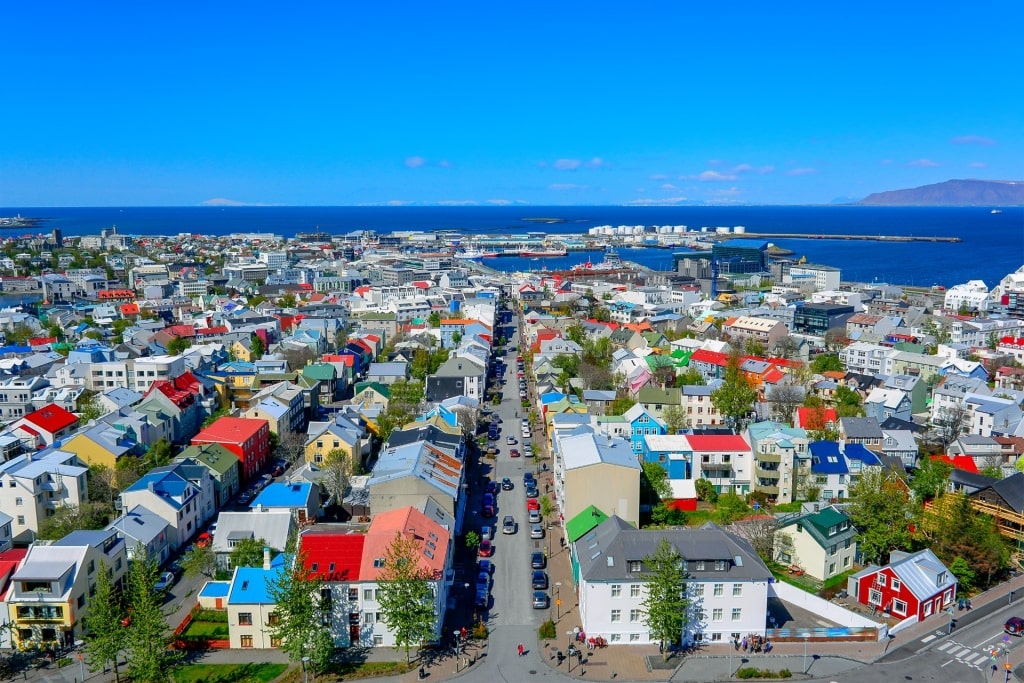
Downtown Reykjavik
Laugavegur, Bankastraeti, and Austurstraeti (one leads onto the other) is the main artery of downtown Reykjavik, a neighborhood that’s worlds away from Iceland’s more remote corners. Bars and bakeries, vibrant street art, and a slew of vintage stores lend a buzzy and modern vibe to this hip quarter of the capital.
Before exploring, stop by Sandholt for freshly-made bakes. Ask for the chocolate hazelnut Danish roll—it tastes outrageously good with chocolate-vanilla cream and hazelnut praline.
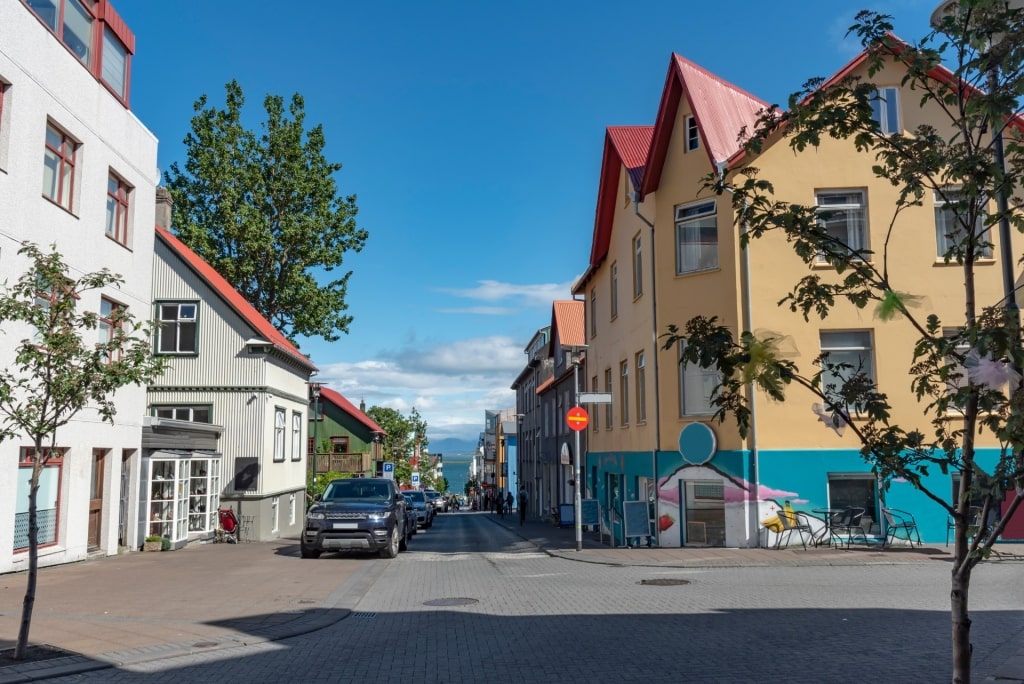
Downtown Reykjavik
One of the best things to do in Reykjavik is to explore the downtown shopping scene. There’s plenty of choice, from independent designer wear to arts and crafts.
Lundinn is filled with Icelandic souvenirs, Art Gallery 101 displays fine art and gifts by local artists and makers, and Andrea Ellen Handcrafted Jewelry sells pretty Icelandic pieces. There’s an outpost of Blue Lagoon, Iceland’s famous geothermal baths on the Reykjanes Peninsula, for mineral-rich masks and serums, too.
Once you’ve shopped for local treasures and admired the eye-catching street art, stop by a wine bar—Mikki Refur Natural Wine Bar on Hverfisgata is chic and intimate—before settling on a restaurant for some fantastic Icelandic fare.
You’ll be spoiled for choice, with some of Iceland’s best restaurants found in downtown Reykjavik, including Dill, Ox, Sumac, Eiriksson Brasserie, and Krons.
Budir
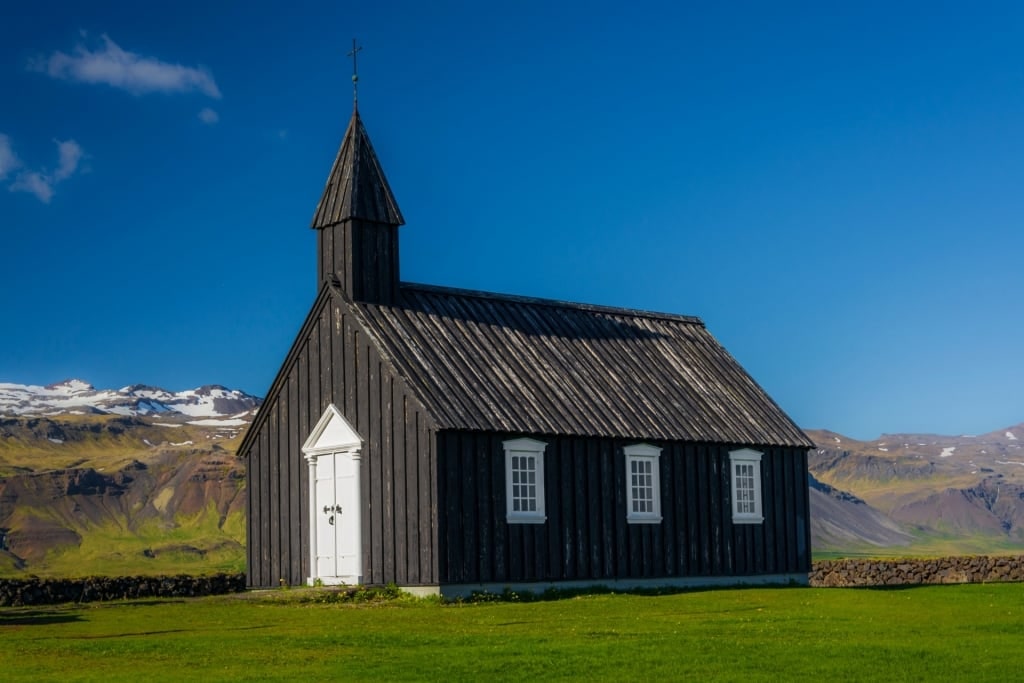
Budir
This tiny hamlet on the Snaefellsnes Peninsula in the west of Iceland was once a thriving fishing village. Today, the fishing boats have left, but this blockbuster landscape remains untouched, including Snaefellsjokull, a glacier-covered stratovolcano that looms over lava fields, coastal dunes, and hiking trails.
First stop by Budir’s melancholic black church. Built in the 19th century, it stands alone on this windswept coastline. Travelers can follow the grassy path from the church to the nearby beach, where the sand is soft and golden, adorned with black volcanic rock formations.
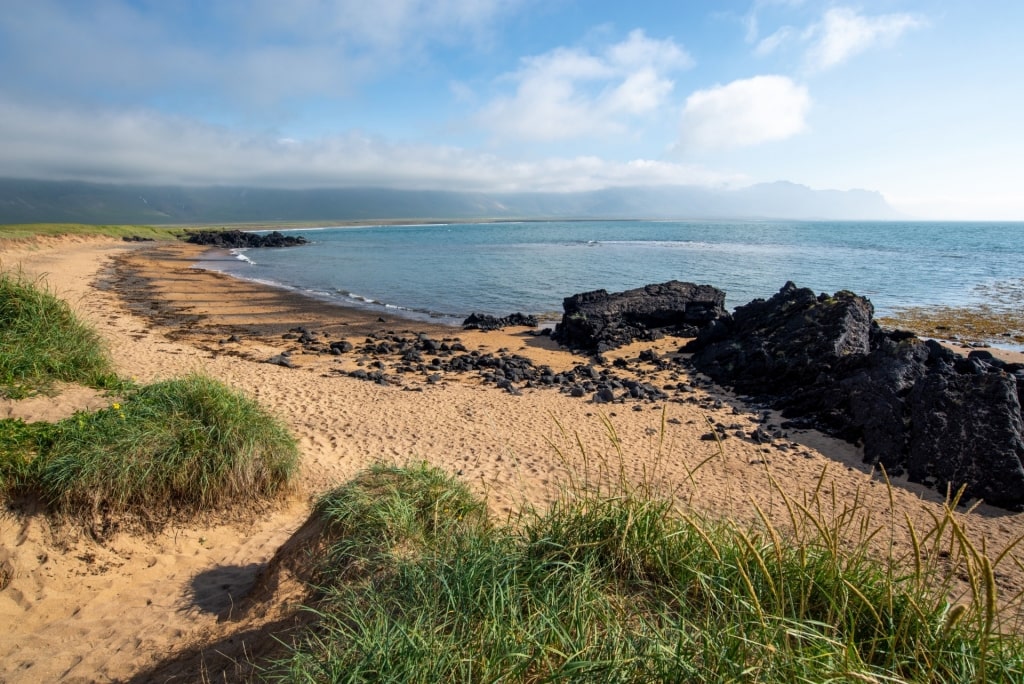
Beach in Budir
Continue the short distance on green, lichen-covered tracks from the beach to Búðaklett, a volcanic crater that flowed with lava thousands of years ago. There are a few lava caves here that visitors can enter, including Búðahellir.
Aside from the odd guest house, there are few facilities around this swathe of the Snaefellsnes Peninsula so pack all of the essentials that you’ll need for a day out.
Vatnajokull National Park
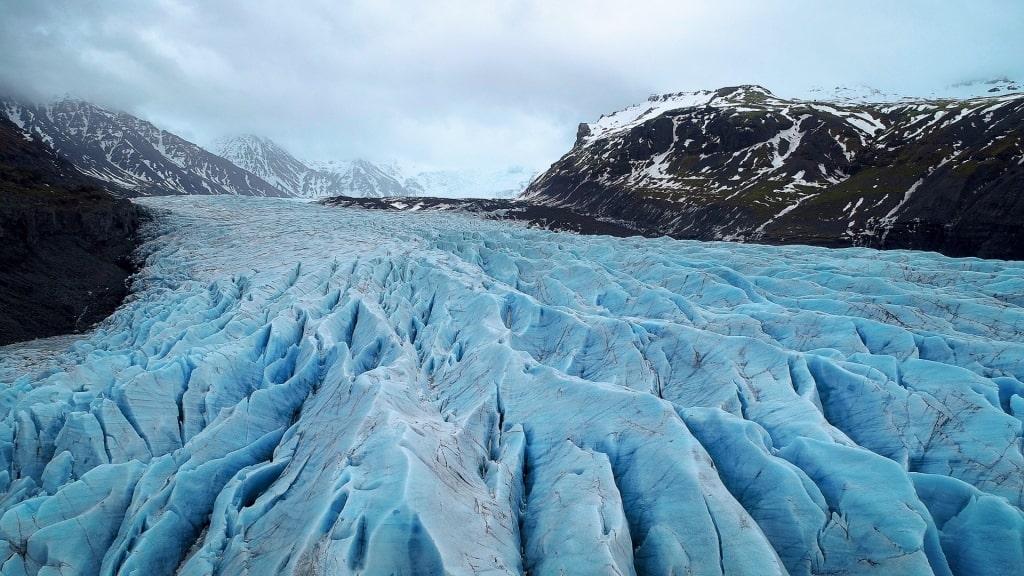
Vatnajokull National Park
Vatnajokull National Park is one of the best places to visit in Iceland, taking up a staggering 14 percent of the country’s landmass. Everything about Vatnajokull is super-sized. It’s home to one of the largest glaciers in Europe, big enough to be visible from space, and concealing several lively volcanoes, including Grimsvotn, one of the most active in Iceland.
This UNESCO-listed park is so vast it would take days, maybe longer, to cover all of it. Opt for a local guide and focus on a specific area or landmark. During summertime, park rangers offer complimentary guided walks across Vatnajokull to share their knowledge of this spine-tingling landscape.
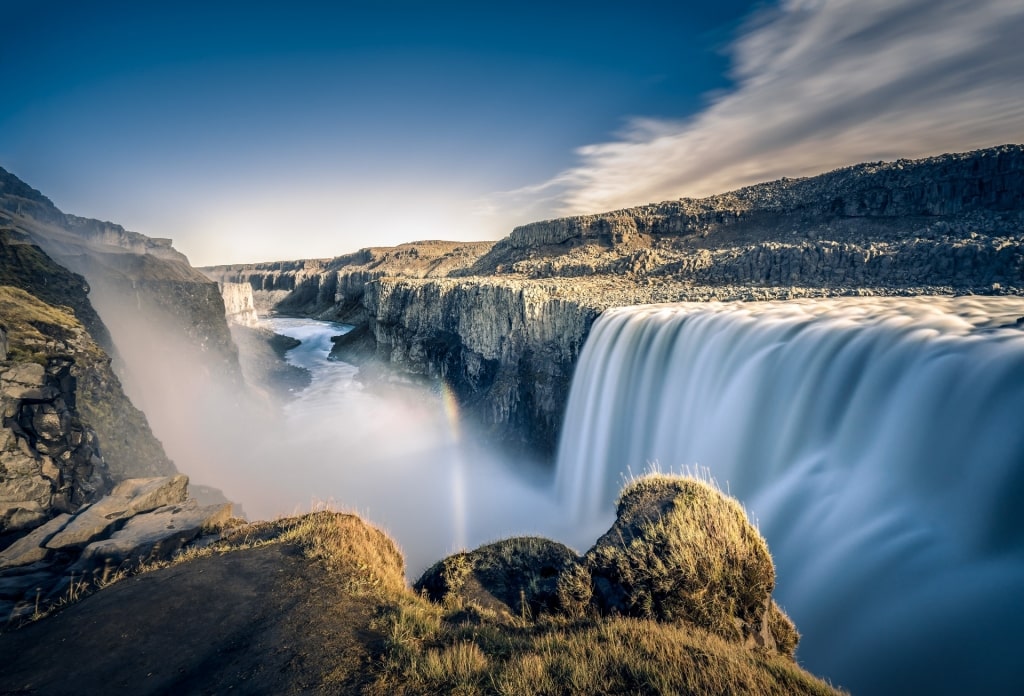
Dettifoss
You could go to Dettifoss in the north of Vatnajokull National Park. It’s the most powerful waterfall in Europe, reached in under two hours from Akureyri, with 9,500-cubic feet of water thundering down every second.
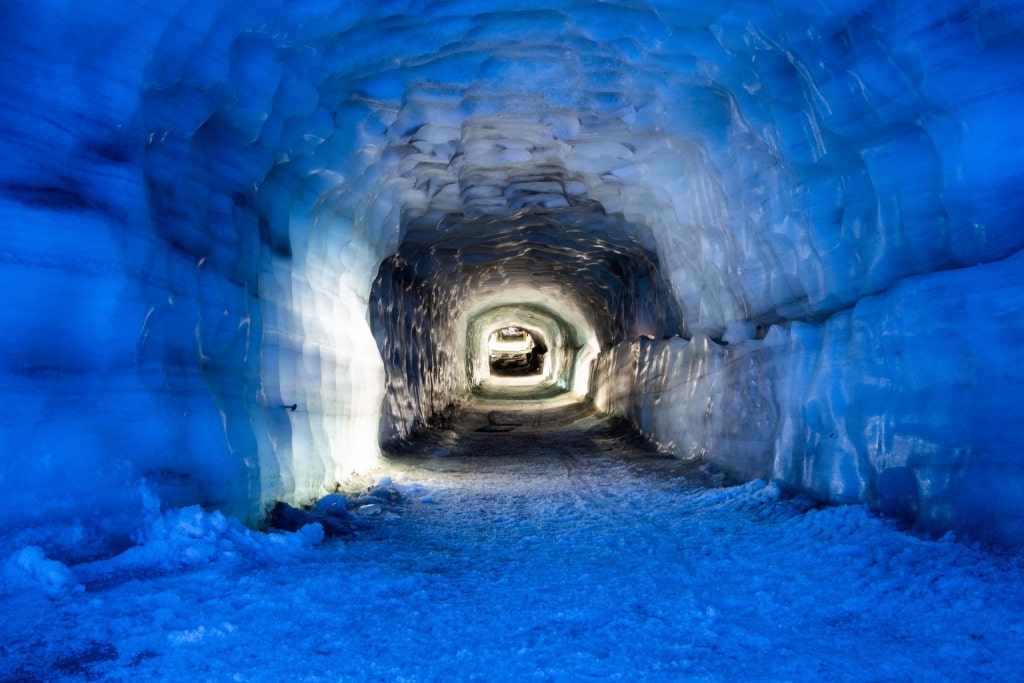
Langjokull
Or perhaps opt for Langjokull, the second-largest glacier in Iceland, where hiking offers wondrous sights, including jaw-dropping vivid blues from inside a man-made tunnel.
Wear comfortable hiking boots and layers up for a visit to Vatnajokull. Water, snacks, and a camera are all essential, too.
Geysir Geothermal Area
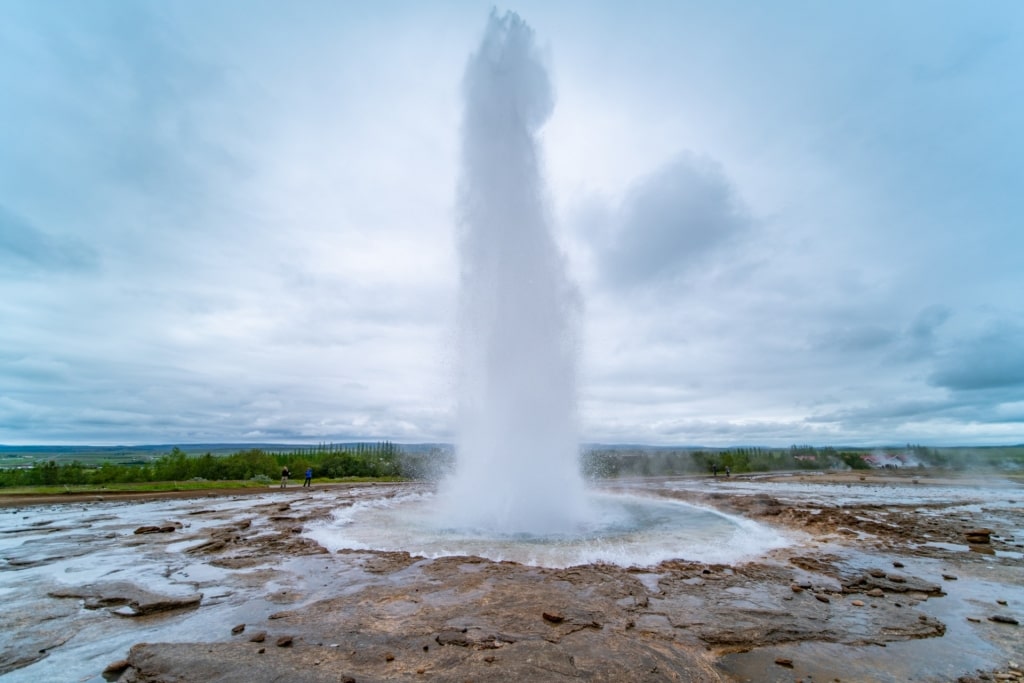
Geysir Geothermal Area
Along with the Blue Lagoon and Hallgrimskirkja, Geysir Geothermal Area is one of the most recognizable places in Iceland. It’s also one of the best places to visit, with its billowing hot eruptions forcing plumes of hot steam and water into the air every few minutes.
Since the area’s Great Geysir has been mostly dormant since the early 20th century, Strokkur is the biggest draw, erupting roughly every 10 minutes with columns of boiling water spouting almost 100 feet.
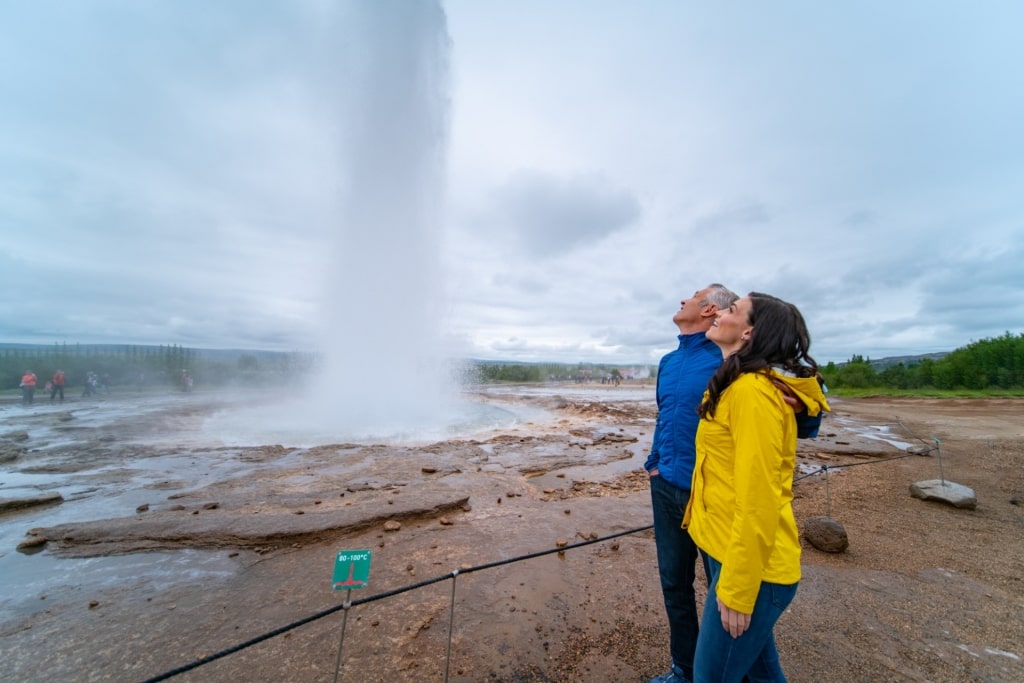
Geysir Geothermal Area
The area features patches of bubbling hot sulfurous mud, warm streams, fumaroles, and hot springs, with a hot cauldron simmering below the earth’s surface.
Visit during summer, when the days are lighter and temperatures milder, and stop by the nearby Geysir Centre where there’s a shop selling cozy warm knits, and a restaurant, Glíma, serving a seasonal Icelandic menu, including excellent cod and lamb.
Summer is a fantastic time to visit Iceland, when travelers can kayak, hike, swim, and visit some of the more far-flung places in the country.
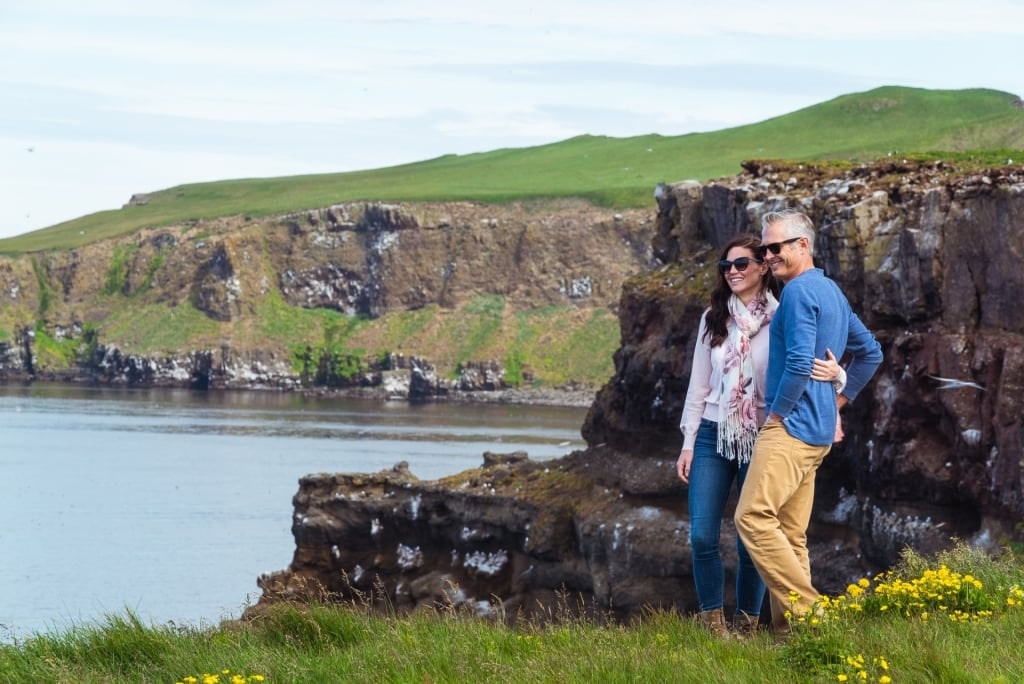
Grimsey Island
Discover Celebrity Cruises’ exciting cruises to Iceland and book your next unforgettable vacation.
